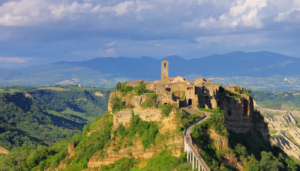Autumn in Tuscany brings with it a culinary treasure that captures the very essence of the season – Castagnaccio. This humble dessert features the seasonal star in Italy of la castagna (the chestnut). It’s made from chestnut flour, raisins, pine nuts, and a hint of rosemary, embodies simplicity and rustic charm. With its delicate sweetness and a moist, almost tender center, Castagnaccio has been a beloved autumn treat for generations.
Humble Beginnings
The origins of Castagnaccio date back to the 1500s, a time when Tuscan peasants had to make the most of what they had. Armed with minimal ingredients – just water and chestnut flour – they created a dish that was not only hearty but bursting with flavor. It was a humble yet sustaining treat that could keep them going for days.
Castagnaccio’s culinary journey didn’t stop there. It gradually spread through the Apennine heartlands of central Italy, where it acquired various regional names like Baldino and Pattona. However, it wasn’t until the 19th century that it ventured northward, finding its way to new regions and evolving with the addition of raisins and pine nuts.
Regional Variations
As with any cherished tradition, Castagnaccio has evolved over time, resulting in a variety of expressions throughout Italy. Some versions incorporate sugar, milk, or ricotta, while others introduce dried fruits or even chocolate.
Today we’re taking it back to basics and sharing an authentic Tuscan Castagnaccio recipe – a version that’s sugar-free, egg-free, and butter-free, making it suitable for those with dietary restrictions or vegans. Not only is it true to its roots, but it’s also incredibly easy to prepare, making it a delightful treat for all ages.
Recipe
- 500 g of excellent quality chestnut flour
- 500/550 g of water
- 120 g of golden raisins
- 100g of pine nuts
- 1 sprig of rosemary
- a pinch of salt
- a drizzle of extra virgin olive oil
- Begin by soaking the raisins in water for about 5 minutes.
- While the raisins soak, mix the chestnut flour and a pinch of salt in a bowl. Gradually add water, stirring with a hand whisk. The key is to achieve a soft, velvety dough that can fall in a ribbon without being too liquidy. If the flour absorbs too much liquid, add an additional 50 g of water.
- Add most of the pine nuts and soaked raisins to the dough, reserving a small portion. Mix them thoroughly.
- Pour the mixture into a greased pan, drizzle with extra virgin olive oil, and sprinkle the reserved pine nuts, raisins, and rosemary needles on top.
- Bake at 180°C (~350°F) in the middle part for approximately 25-30 minutes. After 25 minutes, test it with a wooden toothpick. Continue cooking only if the toothpick doesn’t come out clean.
Tips & Tricks
- To achieve the perfect Castagnaccio, it’s essential not to overcook it. Since it’s a relatively thin cake, especially when using shallow molds, it cooks quickly.
- The ideal result is when the toothpick sinks into a firm but soft and slightly moist cake. The surface should have minimal cracks and not be burnt.
- Once you’ve removed your Castagnaccio from the oven, let it cool in the pan. It’s best enjoyed completely cool, allowing you to savor the essence of autumn with every bite. Its subtle sweetness pairs beautifully with a dollop of cream!
- Castagnaccio can be stored at room temperature for about 3 days. As time passes, its flavors continue to deepen, and the aroma of autumn becomes even more pronounced.
Embrace the season and share the warmth of Castagnaccio with your loved ones. It’s a delightful way to welcome autumn’s embrace, one slice at a time. 🌰🍂




